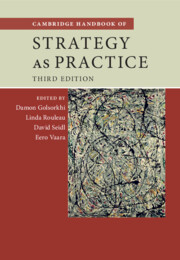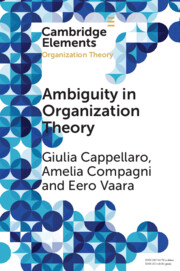35 results

Cambridge Handbook of Strategy as Practice
- Coming soon
-
- Expected online publication date:
- August 2024
- Print publication:
- 31 August 2024
-
- Book
- Export citation

Ambiguity in Organization Theory
- From Intrinsic to Strategic Perspectives
-
- Published online:
- 12 January 2023
- Print publication:
- 02 February 2023
-
- Element
- Export citation
Chapter 2 - Participation Research and Open Strategy
- from Part I - The Concept of Open Strategy
-
-
- Book:
- Cambridge Handbook of Open Strategy
- Published online:
- 13 July 2019
- Print publication:
- 18 July 2019, pp 27-40
-
- Chapter
- Export citation
List of tables
-
- Book:
- Cambridge Handbook of Strategy as Practice
- Published online:
- 05 October 2015
- Print publication:
- 03 September 2015, pp x-x
-
- Chapter
- Export citation
Preface to the Second Edition
-
-
- Book:
- Cambridge Handbook of Strategy as Practice
- Published online:
- 05 October 2015
- Print publication:
- 03 September 2015, pp xxv-xxvi
-
- Chapter
- Export citation
35 - Participation in strategy work
- from Part V - Substantive Topic Areas
-
-
- Book:
- Cambridge Handbook of Strategy as Practice
- Published online:
- 05 October 2015
- Print publication:
- 03 September 2015, pp 616-631
-
- Chapter
- Export citation
Part V - Substantive Topic Areas
-
- Book:
- Cambridge Handbook of Strategy as Practice
- Published online:
- 05 October 2015
- Print publication:
- 03 September 2015, pp 545-546
-
- Chapter
- Export citation
Part IV - Methodological Resources
-
- Book:
- Cambridge Handbook of Strategy as Practice
- Published online:
- 05 October 2015
- Print publication:
- 03 September 2015, pp 429-430
-
- Chapter
- Export citation
List of contributors
-
- Book:
- Cambridge Handbook of Strategy as Practice
- Published online:
- 05 October 2015
- Print publication:
- 03 September 2015, pp xii-xxiv
-
- Chapter
- Export citation
Contents
-
- Book:
- Cambridge Handbook of Strategy as Practice
- Published online:
- 05 October 2015
- Print publication:
- 03 September 2015, pp v-viii
-
- Chapter
- Export citation
Introduction: what is strategy as practice?
-
-
- Book:
- Cambridge Handbook of Strategy as Practice
- Published online:
- 05 October 2015
- Print publication:
- 03 September 2015, pp 1-30
-
- Chapter
- Export citation
Part I - Ontological and Epistemological Questions
-
- Book:
- Cambridge Handbook of Strategy as Practice
- Published online:
- 05 October 2015
- Print publication:
- 03 September 2015, pp 31-32
-
- Chapter
- Export citation
Part III - Theoretical Resources: Organization and Management Theories
-
- Book:
- Cambridge Handbook of Strategy as Practice
- Published online:
- 05 October 2015
- Print publication:
- 03 September 2015, pp 281-282
-
- Chapter
- Export citation
Part II - Theoretical Resources: Social Theory
-
- Book:
- Cambridge Handbook of Strategy as Practice
- Published online:
- 05 October 2015
- Print publication:
- 03 September 2015, pp 143-144
-
- Chapter
- Export citation
List of boxes
-
- Book:
- Cambridge Handbook of Strategy as Practice
- Published online:
- 05 October 2015
- Print publication:
- 03 September 2015, pp xi-xi
-
- Chapter
- Export citation
Index
-
- Book:
- Cambridge Handbook of Strategy as Practice
- Published online:
- 05 October 2015
- Print publication:
- 03 September 2015, pp 647-664
-
- Chapter
- Export citation
28 - Critical discourse analysis as methodology in strategy-as-practice research
- from Part IV - Methodological Resources
-
-
- Book:
- Cambridge Handbook of Strategy as Practice
- Published online:
- 05 October 2015
- Print publication:
- 03 September 2015, pp 491-505
-
- Chapter
- Export citation

Cambridge Handbook of Strategy as Practice
-
- Published online:
- 05 October 2015
- Print publication:
- 03 September 2015
List of figures
-
- Book:
- Cambridge Handbook of Strategy as Practice
- Published online:
- 05 October 2015
- Print publication:
- 03 September 2015, pp ix-ix
-
- Chapter
- Export citation
Frontmatter
-
- Book:
- Cambridge Handbook of Strategy as Practice
- Published online:
- 05 October 2015
- Print publication:
- 03 September 2015, pp i-iv
-
- Chapter
- Export citation



